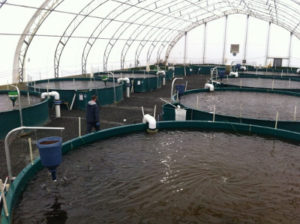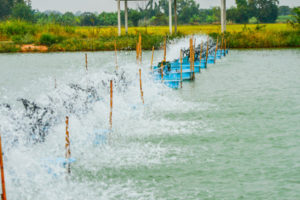
This is one of the reasons why the trend in fish farming is towards indoor aquaculture. There, the fish are kept in small groups in tanks. See also photo on the left. It is believed that the risk of infection is lower with fish in smaller units. When small salmon are infested with a bacterium or lice in marine fish farming, it is very difficult to prevent the lice from spreading to neighboring units.
In indoor aquaculture, the water is treated separately for each tank. The risk of water quality being affected by bird droppings containing organic matter or bacteria is almost zero. The feeding is precisely planned and dosed. Each tank is electronically monitored. In this way you can control the water quality, the salinity and the water temperature. And you can react quickly if necessary and sort out sick fish. Such a fish farm no longer has to be located by the sea, but can be located somewhere inland.
The disadvantage of this method, in the hall one usually has no fresh sea water available or fresh water from the fjord. Water lacks its naturalness, its natural minerality and above all oxygen. Oxygen comes in the sea through waves or in rivers and streams flowing over stones into the water. However, if drinking water is used and recycled, i.e. purified and filtered, oxygen and other minerals must be added.
Dissolved oxygen increased by Merus

Therefore, oxygen is very often dosed directly into the water in aquacultures. With this dosage, better results are achieved than with the mechanical methods.
Merus rings were installed in such a hitech aquaculture in the mid of North America, very far away from the sea. The task to solve corrosion and algae problems in the water system. The operator noticed in his scada system, that since the Merus rings are installed the oxygen concentration in the water is significantly higher than before. This is due to Merus‘ ability to increase the solubility of all substances soluble in water.
The Merus rings are installed in this open circuit. We install Bio Rings, because with these 2 problems can be tackled. We reduce the growth of algae and at the same time, increase the oxygen in the water.
